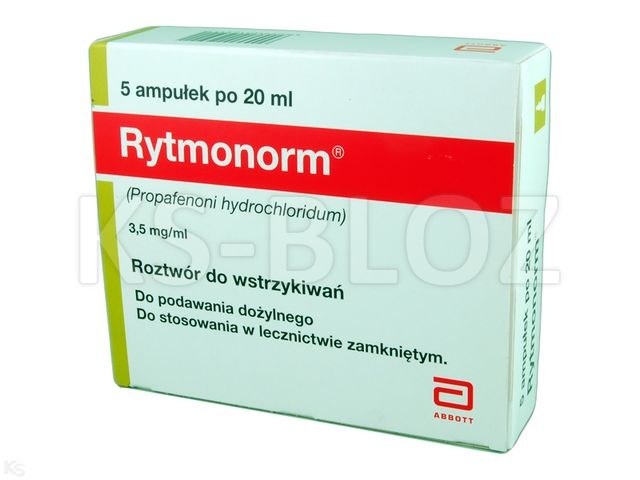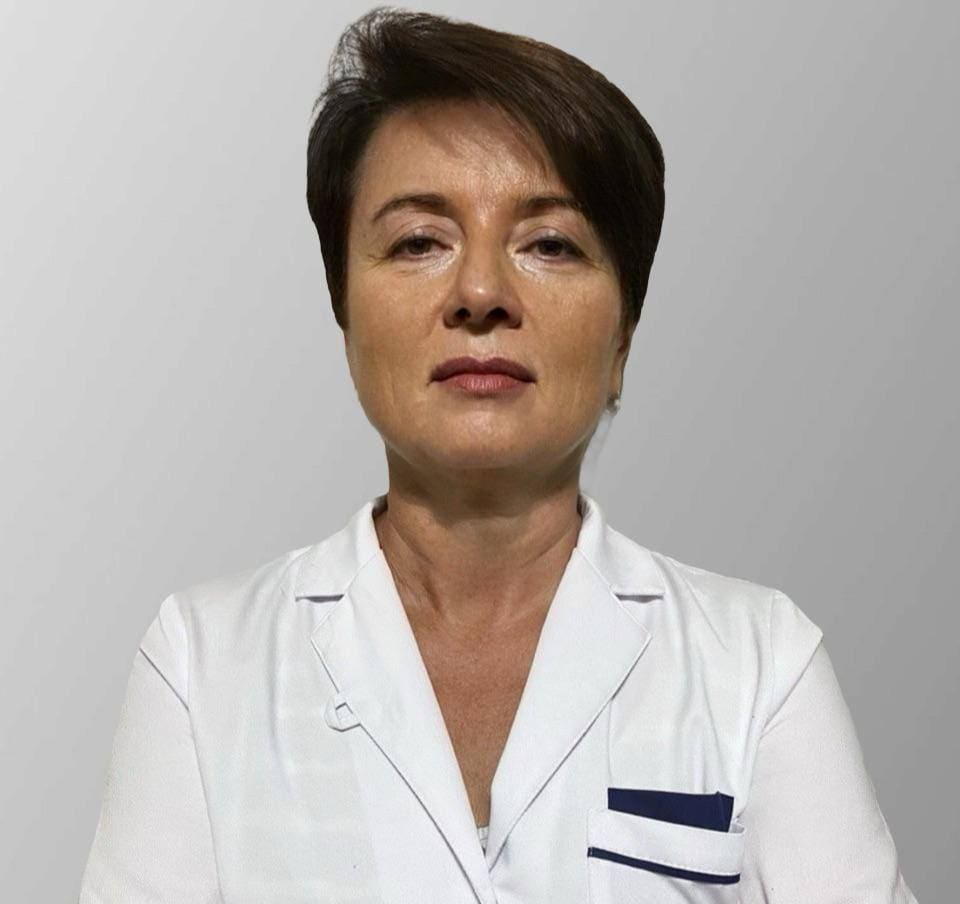

РИТМОНОРМ 3,5 мг/мл РОЗЧИН ДЛЯ ІН'ЄКЦІЙ

Запитайте лікаря про рецепт на РИТМОНОРМ 3,5 мг/мл РОЗЧИН ДЛЯ ІН'ЄКЦІЙ

Інструкція із застосування РИТМОНОРМ 3,5 мг/мл РОЗЧИН ДЛЯ ІН'ЄКЦІЙ
Введення
Опис: інформація для пацієнта
Rytmonorm 3,5 мг/мл розчин для ін'єкцій
Гідрохлорид пропафенону
Всією увагою прочитайте цей опис перед початком використання ліків, оскільки він містить важливу інформацію для вас.
- Збережіть цей опис, оскільки вам може знадобитися знову його прочитати.
- Якщо у вас виникли питання, проконсультуйтеся з лікарем, фармацевтом або медсестрою.
- Ці ліки призначені тільки вам, не давайте їх іншим людям, навіть якщо вони мають такі самі симптоми, оскільки це може їм нашкодити.
- Якщо ви відчуваєте побічні ефекти, проконсультуйтеся з лікарем, фармацевтом або медсестрою, навіть якщо це побічні ефекти, які не вказані в цьому описі. Див. розділ 4.
Зміст опису
- Що таке Rytmonorm і для чого він використовується
- Що потрібно знати перед початком використання Rytmonorm
- Як використовувати Rytmonorm
- Можливі побічні ефекти
- Зберігання Rytmonorm
- Зміст упаковки та додаткова інформація
1. Що таке Rytmonorm і для чого він використовується
Rytmonorm - це лікарський засіб, який використовується для лікування порушень серцевого ритму різного походження. Він належить до групи лікарських засобів, званих антиаритмічними засобами класу 1C за Воганом Вільямсом.
Rytmonorm використовується для лікування та профілактики пароксизмальної надшлуночкової тахікардії, яка включає атриальну фібриляцію та пароксизмальний фібриляційний тахікардія та тахікардію, викликану феноменами реентрансу, які впливають на атриовентрикулярний вузол або додаткові шляхи (синдром Вольфа-Паркінсона-Уайта). Лікування та профілактика вентрикулярних аритмій, які включають симптоматичні вентрикулярні екстрасистоли та/або нестійку та стійку вентрикулярну тахікардію.
2. Що потрібно знати перед початком використання Rytmonorm
Не використовуйте Rytmonorm
- Якщо ви алергічні на активну речовину або на будь-який інший компонент цього лікарського засобу (включно з розділом 6).
- Якщо у вас є анамнез синдрому Бругада (спадкова хвороба, характеризується аномалією на електрокардіограмі (ЕКГ) та підвищеним ризиком раптової смерті) (див. Попередження та обережність).
- Якщо ви мали інфаркт міокарда протягом 3 місяців до початку лікування.
- Якщо у вас є значна хвороба серця, така як:
- серцева недостатність.
- кардіогенний шок, якщо тільки причиною не є аритмія.
- гостра брадикардія.
- ви маєте дисфункцію синусового вузла, дефекти провідності, атриовентрикулярний блок другого ступеня або вище або блок гілки або дистальний блок у відсутності штучного кардіостимулятора.
- Якщо у вас є сильне зниження артеріального тиску.
- Якщо ви страждаєте порушенням балансу електролітів у крові (наприклад, порушення метаболізму калію).
- Якщо у вас є важка обструктивна хвороба легень.
- Якщо у вас є міастенія.
- Якщо ви приймаєте ритонавір (антиретровірусний препарат, який використовується для лікування інфекції ВІЛ, див. Використання Rytmonorm з іншими лікарськими засобами).
Попередження та обережність
Проконсультуйтеся з лікарем, фармацевтом або медсестрою перед початком використання Rytmonorm.
- Це важливо, щоб кожен пацієнт, який отримує пропафенон, був клінічно та електрокардіографічно оцінений перед початком лікування та під час лікування Rytmonorm, щоб визначити, чи виправдовує відповідь на пропафенон продовження лікування.
- Після лікування цим лікарським засобом лікар повинен виключити синдром Бругада, який міг бути присутнім без будь-яких попередніх симптомів.
- Якщо ви маєте кардіостимулятор, лікування може вплинути на нього, тому потрібно контролювати та, якщо необхідно, перепрограмувати його.
- Якщо у вас є атриальна фібриляція, оскільки Rytmonorm може призвести до появи більш важкої аритмії; див. Можливі побічні ефекти.
- Якщо у вас є важка серцева хвороба, оскільки ви можете бути схильні до важких побічних ефектів, і в цьому випадку лікування цим лікарським засобом протипоказане.
- Якщо у вас є бронхіальна астма або інша хронічна обструктивна хвороба дихальної системи.
Діти
Студії взаємодії проводилися тільки у дорослих, тому невідомо, чи такі самі взаємодії відбуваються у дітей.
Пацієнти похилого віку
У пацієнтів похилого віку Rytmonorm повинен використовуватися з великою обережністю.
Використання Rytmonorm зіншими лікарськими засобами
Повідомте лікаря або фармацевта, якщо ви використовуєте, нещодавно використовували або можете використовувати будь-який інший лікарський засіб.
Можливі більш часті побічні ефекти з Rytmonorm, якщо його застосовують з місцевими анестетиками (наприклад, для імплантації кардіостимулятора, хірургічних чи стоматологічних процедур), а також з іншими лікарськими засобами, які мають інгібуючу дію на серце, такими як бета-блокатори (для гіпертонії) або деякі антидепресанти.
Повідомте лікаря, якщо ви приймаєте будь-який з наступних лікарських засобів, оскільки вони можуть збільшити рівень пропафенону в крові:
- венлафаксин (для депресії)
- пропранолол (для гіпертонії та стенокардії)
- метопролол (для гіпертонії)
- дезіпрамін (для депресії)
- циклоспорин (для зниження імунітету)
- теофілін (для бронхіальної астми)
- дігоксин (для серцевих проблем)
Якщо спостерігаються ознаки передозування, дози цих лікарських засобів повинні бути зменшені відповідно.
Повідомте лікаря, якщо ви приймаєте будь-який з наступних лікарських засобів, оскільки вони можуть збільшити рівень гідрохлориду пропафенону в крові, тому може знадобитися моніторинг та корекція дози:
- кетоконазол (проти грибкових інфекцій)
- циметидин (для виразкової хвороби шлунка)
- хінідин (для аритмій серця або проти малярії)
- еритроміцин (антібіотик)
- флуоксетин (для депресії)
- пароксетин (для депресії)
Також спостерігається збільшення рівня гідрохлориду пропафенону при застосуванні грейпфрутового соку.
Спільне застосування Rytmonorm та аміодарону може призвести до порушень серцевої діяльності. Можливо, буде потрібно коригування дози обох лікарських засобів.
Спільне застосування пропафенону та лідокаїну збільшує ризик побічних ефектів лідокаїну на центральну нервову систему.
Повідомте лікаря, якщо ви приймаєте будь-який з наступних лікарських засобів, оскільки вони можуть зменшити ефективність Rytmonorm:
- рифампіцин (антібіотик)
- фенобарбітал (седативний та антиепілептичний препарат)
- фенітоїн (антієпілептичний препарат)
- карбамазепін
У разі хронічного лікування фенобарбіталом та/або рифампіцином та Rytmonorm необхідно контролювати відповідь на лікування Rytmonorm.
Повідомте лікаря, якщо ви приймаєте лікарські засоби для профілактики згортання крові (наприклад, аценокумарол або варфарин), оскільки Rytmonorm може збільшити ефективність цих лікарських засобів, підвищуючи ризик кровотечі. Якщо спостерігаються ознаки передозування, дози цих лікарських засобів повинні бути зменшені.
Вагітність, лактація та фертильність
Якщо ви вагітні або перебуваєте в період лактації, вважаєте, що можете бути вагітною або плануєте вагітність, проконсультуйтеся з лікарем або фармацевтом перед застосуванням цього лікарського засобу.
Немає достатніх та добре контрольованих досліджень у вагітних жінок. Rytmonorm не повинен застосовуватися під час вагітності, якщо тільки очікувана користь не виправдовує потенційний ризик для плода. Гідрохлорид пропафенону проходить через плацентарний бар'єр.
Не вивчено виділення гідрохлориду пропафенону в грудне молоко. Обмежені дані свідчать про те, що гідрохлорид пропафенону може виділятися в грудне молоко, тому його застосування повинно проводитися з обережністю у жінок під час лактації.
Відновлення та використання машин
Під час лікування можуть виникнути розмита зір, головокружіння, втома або зниження артеріального тиску, тому якщо ви відчуваєте ці симптоми, не повинні водити автомобіль чи керувати важкими машинами.
3. Як використовувати Rytmonorm
Rytmonorm для ін'єкцій вводиться внутрішньовенно.
Слідувати точно інструкціям щодо застосування цього лікарського засобу, вказаним лікарем, фармацевтом або медсестрою. У разі сумнівів зверніться до лікаря, фармацевта або медсестри.
Лікар визначить, яка доза Rytmonorm найкраще підходить вам.
Дорослі:
Лікування повинно бути адаптовано індивідуально та визначено з контролем електрокардіограми та артеріального тиску.
Зазвичай застосовується одна доза 1 мг/кг маси тіла, хоча часто можна досягти бажаного ефекту з дозою 0,5 мг/кг. За необхідності можна збільшити одну дозу до 2 мг/кг маси тіла. Однак лікар визначить, яка доза Rytmonorm найкраще підходить вам.
Лікування повинно розпочинатися з найменшої можливої дози, підтримуючи пацієнта під уважним спостереженням та з тісним моніторингом ЕКГ та артеріального тиску.
Внутрішньовенні ін'єкції повинні вводитися повільно протягом 3-5 хвилин, а інтервал між ін'єкціями не повинен бути менше 90-120 хвилин. Якщо спостерігається подовження інтервалу QRS або інтервалу QT, виправленого за частотою, на більше ніж 20%, введення ін'єкції повинно бути припинено негайно.
Інфузія короткої тривалості
Коли Rytmonorm застосовується в інфузії короткої тривалості, протягом однієї-трьох годин, швидкість дозування становить 0,5-1 мг/хв.
Повільна внутрішньовенна інфузія
Коли Rytmonorm застосовується в повільній внутрішньовенній інфузії, зазвичай достатньо добової максимальної дози 560 мг. Для отримання розчину слід використовувати глюкозу або фруктозу (5%). Не слід використовувати фізіологічний розчин хлориду натрію через можливість осадження.
Пацієнти з печінковою недостатністю
Не рекомендується коригування дози у пацієнтів з помірною печінковою недостатністю. Ці пацієнти повинні розпочинати з найменшої рекомендованої дози та підлягати уважному моніторингу. Пацієнти з важкою печінковою недостатністю повинні розпочинати з половини дози або менше, ніж рекомендована для пацієнтів з нормальною функцією печінки. Ці пацієнти повинні підлягати уважному моніторингу, а коригування дози повинно проводитися на основі клінічних симптомів.
Пацієнти з нирковою недостатністю
Не потрібно коригування дози при внутрішньовенному застосуванні у пацієнтів з нирковою недостатністю, хоча пропафенон повинен застосовуватися з обережністю у цьому типу пацієнтів.
Пацієнти похилого віку
Rytmonorm повинен застосовуватися з обережністю, звертаючи особливу увагу на клінічні та електрокардіографічні ознаки токсичності.
Застосування у дітей
Немає досвіду застосування у дітей.
Якщо ви вважаєте, що дія Rytmonorm надто сильна або слабка, повідомте про це лікаря або фармацевта.
Якщо ви застосували більше Rytmonorm, ніж потрібно
Якщо ви отримали більше Rytmonorm, ніж потрібно, ви можете відчувати серцеві ефекти та зниження артеріального тиску, які в важких випадках можуть призвести до кардіогенного шоку. Часто спостерігаються головний біль, головокружіння, розмита зір, оніміння або поколювання шкіри, тремор, нудота, запор та сухість у роті.
При важких отруєннях спостерігаються конвульсії, оніміння або поколювання шкіри, сонливість, кома та зупинка дихання. Були випадки смерті.
Якщо це трапилося, пацієнта потрібно спостерігати в реанімаційному відділенні.
Якщо ви застосували більше Rytmonorm, ніж потрібно, негайно зверніться до лікаря або фармацевта або телефонуйте в Токсикологічну службу, телефон 91 562 04 20, вказуючи назву лікарського засобу та кількість, прийняту.
4. Можливі побічні ефекти
Як і всі лікарські засоби, цей лікарський засіб може викликати побічні ефекти, хоча не всі люди їх відчувають.
Побічні ефекти класифікуються як дуже часті (можуть впливати на більше ніж 1 з 10 осіб), часті (можуть впливати до 1 з 10 осіб), рідкісні (можуть впливати до 1 з 100 осіб) та частота невідома (не може бути оцінена з наявних даних).
Дуже часті побічні ефекти, пов'язані з лікуванням пропафеноном, - це головокружіння, порушення провідності серця (порушення серцевої діяльності) та палпітації.
У межах кожної групи побічні ефекти представлені в порядку зменшення тяжкості, від більшої до меншої, коли це було можливо.
Було повідомлено про наступні побічні ефекти:
Порушення крові та лімфатичної системи
-Рідкісні: зниження кількості тромбоцитів (клітин крові, які беруть участь у згортанні).
-Частота невідома: зниження кількості лейкоцитів (клітин крові, які захищають організм від інфекцій або чужорідних речовин, можуть проявлятися частими інфекціями з гарячкою, ознобом або болем у горлі), зниження кількості гранулоцитів (типу лейкоцитів, який може підвищувати ризик інфекцій), важке зниження кількості гранулоцитів або нейтрофілів (агранулоцитоз, хвороба, при якій людина стає більш схильною до інфекцій).
Порушення імунної системи
-Частота невідома: гіперчутливість1.
1 Може проявлятися холестазом (зупинкою потоку жовчі до дванадцятипалої кишки), порушеннями крові та шкірними висипаннями.
Порушення метаболізму та харчування
-Рідкісні: зниження апетиту.
Психічні порушення
-Часті: тривога, порушення сну.
-Рідкісні: кошмари.
-Частота невідома: стан плутанини.
Порушення нервової системи
-Дуже часті: головокружіння2.
-Часті: головний біль, порушення смаку.
-Рідкісні: короткочасна втрата свідомості (синкоп), порушення координації, оніміння, поколювання або відчуття притуплення в будь-якій частині тіла, але найчастіше в ногах, руках, руках або ногах (парестезія).
-Частота невідома: конвульсії, екстрапірамідні симптоми (неконтрольовані рухи), неспокій2. Включно з вертиго
Очні порушення
Часті: розмита зір.
Порушення вуха та лабіринту
Рідкісні: вертиго
Серцеві порушення
-Дуже часті: порушення провідності серця3(порушення серцевої діяльності), палпітації
-Часті: синусова брадикардія (зниження частоти серцевих скорочень), зниження кількості серцевих скорочень (брадикардія), тахікардія (збільшення кількості серцевих скорочень), атриальний фібриляційний тахікардія (серцевий ритм, який виникає в атриумі).
-Рідкісні: вентрикулярна тахікардія (збільшення кількості серцевих скорочень, які починаються у шлуночках та мають більше ніж 100 скорочень на хвилину), аритмія4(порушення частоти серцевих скорочень, яке може збільшуватися, зменшуватися або ставати нерегулярним).
-Частота невідома: вентрикулярна фібриляція, серцева недостатність5, зниження частоти серцевих скорочень.
3 Включно з синусово-атріовентрикулярним блоком, атриовентрикулярним блоком та внутрішньошлуночковим блоком
4 Пропафенон може бути пов'язаний з проаритмічними ефектами, які проявляються як збільшення частоти серцевих скорочень (тахікардія) або вентрикулярна фібриляція. Деякі з цих аритмій можуть бути загрозливими для життя та можуть потребувати реанімаційних заходів для запобігання потенційно смертельному результату.
5 Може спостерігатися погіршення існуючої серцевої недостатності.
Судинні порушення
-Рідкісні: гіпотонія (зниження артеріального тиску).
-Частота невідома: гіпотонія при тривалому стоянні та/або при піднятті (ортостатична гіпотонія).
Дихальні, грудні та медіастинальні порушення
-Часті: задишка (задишка або труднощі з диханням).
Гastrointestinalні порушення
-Часті: біль у животі, блювота, нудота, діарея, запор, сухість у роті.
-Рідкісні: розтягнення живота (роз゛я'яття живота), метеоризм (гази).
-Частота невідома: рвота, нездужання в шлунку.
Печінкові та жовчеві порушення
-Часті: порушення функції печінки
-Частота невідома: ушкодження печінки, обструкція потоку жовчі з печінки (холестаз), гепатит, жовтяниця (жовтізація шкіри та очей)
Додаткові дослідження
Часті: порушення функції печінки, виявлені в аналізах крові, такі як збільшення аспартатамінотрансферази, збільшення аланінамінотрансферази, збільшення гамма-глутамілтрансферази та збільшення активності алкалічної фосфатази в крові.
Порушення шкіри та підшкірної клітковини
-Рідкісні: кропив'янка, свербіж, висипання на шкірі, еритема (червоність шкіри).
М'язово-скелетні та сполучні тканинні порушення
-Частота невідома: синдром, подібний до системного лупуса (автоімунна хвороба).
Порушення репродуктивної системи та молочних залоз
-Рідкісні: імпотенція (еректильна дисфункція).
-Частота невідома: зниження кількості сперматозоїдів7
7 Зниження кількості сперматозоїдів є оборотнім після припинення застосування пропафенону.
Загальні порушення та порушення в місці застосування
-Часті: біль у грудній клітці, астенія (чуття втоми), втома, гарячка.
Повідомлення про побічні ефекти
Якщо ви відчуваєте будь-який побічний ефект, повідомте про це лікаря, фармацевта або медсестру, навіть якщо це можливі побічні ефекти, які не вказані в цьому описі. Ви також можете повідомити про них безпосередньо через Іспанську систему фармакологічного моніторингу лікарських засобів для людини: https://www.notificaram.es. Повідомляючи про побічні ефекти, ви можете допомогти надати більше інформації про безпеку цього лікарського засобу.
5. Зберігання Ритмонорму
Тримати цей лікарський засіб поза зоною видимості та досягнення дітей.
Не зберігати при температурі вище 30 °C.
Не використовувати цей лікарський засіб після закінчення терміну придатності, вказаного на упаковці після CAD. Термін придатності - останній день місяця, зазначеного.
Лікарські засоби не повинні викидатися у водопровідні труби чи у сміття. Відкладати упаковку та лікарські засоби, які вам не потрібні, у Пункт SIGRE аптеки. Спитайте у свого фармацевта, як позбутися упаковки та лікарських засобів, які вам вже не потрібні. Таким чином ви допоможете захистити навколишнє середовище.
6. Зміст упаковки та додаткова інформація
Склад Ритмонорму
- Активна речовина - гідрохлорид пропафенона. Кожна ампула по 20 мл містить 70 мг гідрохлориду пропафенона.
- Інші компоненти (експіцієнти) - глюкоза моногідрат і вода для ін'єкційних препаратів.
Вигляд продукту та вміст упаковки
Кожна упаковка містить 5 ампул по 20 мл прозорого та безбарвного розчину у безбарвному склі.
Власник дозволу на торгівлю та відповідальна особа за виробництво
Власник
Teva B.V.,
Swensweg 5, 2031GA
Гарлем, Нідерланди
Відповідальна особа за виробництво:
FAMAR HEALTH CARE SERVICES MADRID, S.A.U.
Avda. де Леганес, 62. 28923
Алькоркон-Мадрид.
Ви можете запитати додаткову інформацію про цей лікарський засіб, звернувшись до місцевого представника власника дозволу на торгівлю:
Teva Pharma, S.L.U.
C/ Анабель Сегура, 11, Едифісіо Альбатрос Б, 1-а поверх
Алькобендас 28108 Мадрид
Іспанія
Дата останнього перегляду цьогопроспекту: Березень 2019
Детальна інформація про цей лікарський засіб доступна на сайті {Агенції лікарських засобів та медичних продуктів Іспанії (AEMPS)} (http://www.aemps.gob.es/)
- - - - - - - - - - - - - - - - - - - - - - - - - - - - - - - - - - - - - - - - - - - - - - - - - - - - - - - - - - - - - - - - - -
Ця інформація призначена лише для медичних працівників:
Для продовження лікування перорально та для профілактики нових порушень ритму доступні таблетки Ритмонорм 150 мг та 300 мг.
Лікування передозування
Симптоми передозування:
Симптоми міокарду:Ефекти передозування гідрохлориду пропафенона на міокард проявляються як порушення генерації та проведення стимулів серцевої діяльності, такі як подовження інтервалу PQ, розширення комплексу QRS, пригнічення автоматизму синусового вузла, блокада AV, тахікардія шлуночків, фібриляція шлуночків. Зниження контрактильності (негативний інотропний ефект) може спричинити гіпотонію, яка в тяжких випадках може викликати серцевий шок.
Симптоми не серцевої діяльності:можуть часто з'являтися головний біль, головокружіння, розмита зір, парестезії, тремор, нудота, запор та сухість у роті. У вкрай рідких випадках повідомлялося про конвульсії при передозуванні. Також повідомлялося про смертельні випадки.
При важких інтоксикаціях можуть з'являтися тоніко-клонічні судоми, парестезії, сонливість, кома та зупинка дихання.
Лікування:
Крім загальних заходів екстреної допомоги необхідна моніторинг та корекція життєво важливих показників пацієнта (за необхідності) у відділенні інтенсивної терапії.
Дефібриляція, а також інфузія допаміну та ізопреналіну були ефективними у контролі ритму та артеріального тиску. Конвульсії були полегшені дазепаном внутрішньовенно. Можуть бути необхідні загальні заходи підтримки, такі як механічна вентиляція легень та масаж серця.
Спроби видалення шляхом гемоперфузії мають обмежену ефективність.
Гемодіаліз не є ефективним через високу зв'язування з білками (> 95%) та великий об'єм розподілу.
Несумісності
Ритмонорм ін'єкційний не повинен змішуватися з фізіологічними розчинами, оскільки може осадитися.
Інші форми випуску
Ритмонорм 150 мг таблетки, покриті оболонкою. Упаковки по 30 та 60 таблеток, покритих оболонкою.
Ритмонорм 300 мг таблетки, покриті оболонкою. Упаковки по 20 та 60 таблеток, покритих оболонкою.
- Країна реєстрації
- Доступність у аптекахПроблеми з постачанням
- Діючі речовини
- Потрібен рецептТак
- Виробник
- Інформація є довідковою і не є медичною порадою. Перед прийомом будь-яких препаратів обов'язково проконсультуйтеся з лікарем. Oladoctor не несе відповідальності за медичні рішення, прийняті на основі цього контенту.
- Альтернативи до РИТМОНОРМ 3,5 мг/мл РОЗЧИН ДЛЯ ІН'ЄКЦІЙФорма випуску: ТАБЛЕТКА, 150 мг пропафенону гідрохлоридуДіючі речовини: propafenoneВиробник: Teva B.V.Потрібен рецептФорма випуску: ТАБЛЕТКА, 300 мг пропафенону гідрохлоридуДіючі речовини: propafenoneВиробник: Teva B.V.Потрібен рецептФорма випуску: РОЗЧИН ДЛЯ ІН'ЄКЦІЙ, 10 мг ацетату флекаїніду/млДіючі речовини: flecainideВиробник: Viatris Healthcare LimitedПотрібен рецепт
Аналоги РИТМОНОРМ 3,5 мг/мл РОЗЧИН ДЛЯ ІН'ЄКЦІЙ в інших країнах
Найкращі аналоги з тією самою діючою речовиною та терапевтичним ефектом.
Аналог РИТМОНОРМ 3,5 мг/мл РОЗЧИН ДЛЯ ІН'ЄКЦІЙ у Польща
Аналог РИТМОНОРМ 3,5 мг/мл РОЗЧИН ДЛЯ ІН'ЄКЦІЙ у Україна
Лікарі онлайн щодо РИТМОНОРМ 3,5 мг/мл РОЗЧИН ДЛЯ ІН'ЄКЦІЙ
Консультація щодо дозування, побічних ефектів, взаємодій, протипоказань та поновлення рецепта на РИТМОНОРМ 3,5 мг/мл РОЗЧИН ДЛЯ ІН'ЄКЦІЙ – за рішенням лікаря та згідно з місцевими правилами.










